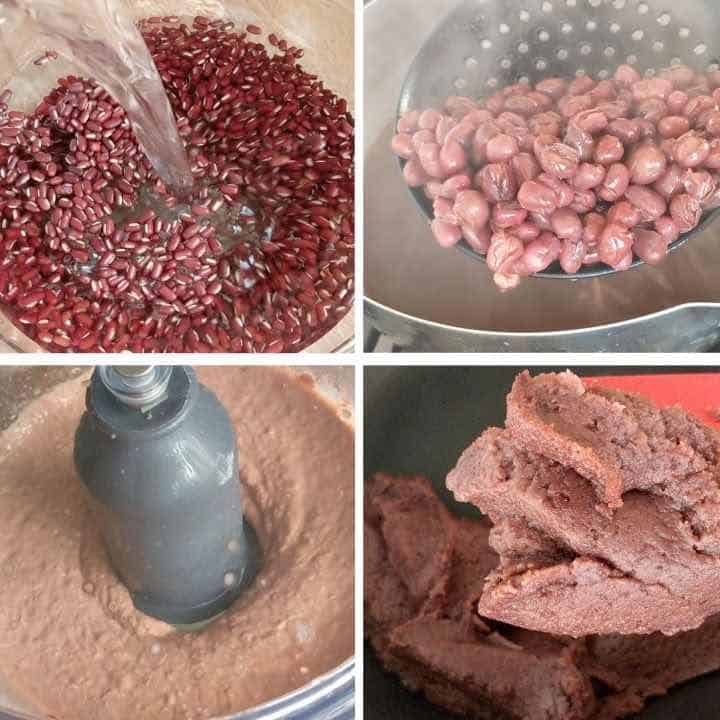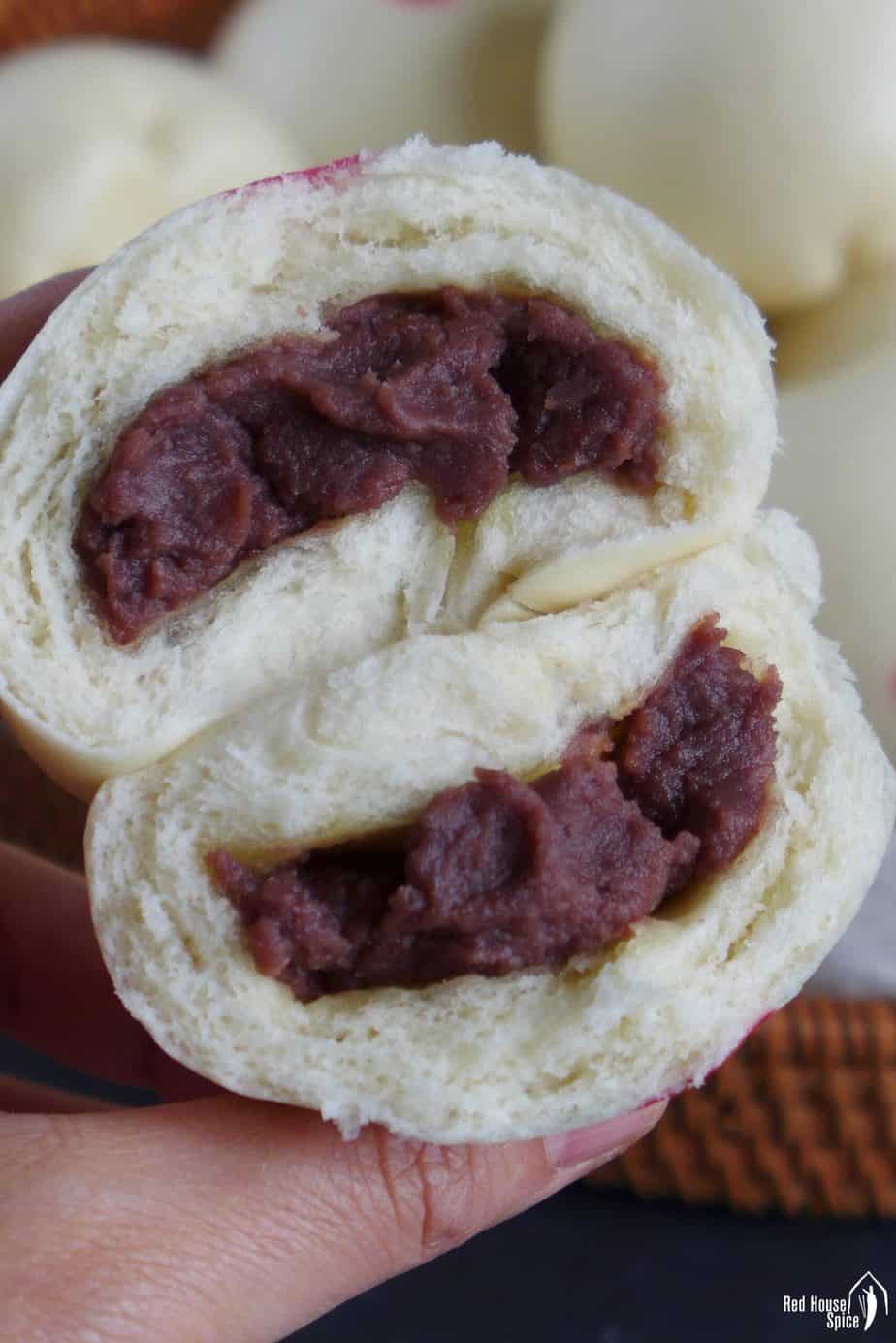When you make Chinese red bean buns from scratch, they taste great. They are soft, fluffy steamed buns filled with sweet, creamy red bean paste. This recipe includes many useful tips and a tutorial video.
Red bean buns, also known as dou sha bao (豆沙包) in Chinese are a popular snack and dessert in many Asian cuisines. Their distinctive appearance – fluffy white buns with a hidden red bean paste filling – makes them easily recognizable. But what exactly do these buns taste like?
As their name suggests, the star ingredient is red bean paste made from adzuki beans. While the beans themselves have a mild, nutty flavor, when cooked down into a paste with sugar they develop a sweet taste reminiscent of sweet potatoes. The resulting filling has a soft, smooth texture similar to sweet bean paste or peanut butter. It provides a rich, creamy counterpoint to the soft, lightly sweetened exterior dough.
A Sweet Yet Slightly Savory Treat
The first thing you’ll notice when taking a bite of a freshly steamed red bean bun is the soft, pillowy texture of the outer bun. This exterior is made from a yeast-leavened dough that puffs up into a cloud-like steamed bun. Though subtly sweet, it mainly serves as a neutral backdrop that complements the sweet bean filling.
Once you get into the center, you’ll reach the hallmark red bean paste. Its uniquely sweet yet slightly grainy texture initially surprises the taste buds. The flavor is difficult to compare to more familiar Western desserts. With its rich sweetness tempered by an underlying roasted bean taste, red bean paste can best be described as a cross between sweetened chestnut paste and whipped sweet potatoes. It has a more complex, roasted depth than the one-note sweetness of buttercream or jam.
Overall, the bean paste adds a wonderfully smooth, substantial mouthfeel and just the right amount of natural sweetness This combines with the soft bun to create a satisfying treat that toes the line between dessert and snack food.
Regional Variations Change The Flavor Profile
Red bean buns come in different shapes, sizes, and styles across Asia. Though the core ingredients remain the same, small tweaks in regional recipes create noticeably different taste experiences:
-
Chinese red bean buns tend to be smaller and rounder, with a higher bun to filling ratio. They have a milder sweetness overall.
-
Japanese anpan have a greater proportion of bean paste, almost like a sandwich. They are less sweet than other versions.
-
In Korea, patbingsu are bigger and breadier, with a texture closer to doughnuts. They highlight the red bean component.
-
Filipino red bean buns balance the beans with cheesy and buttery flavors for a more indulgent combo.
-
Some Vietnamese versions enclose not just red bean paste but a full boiled egg yolk too for an extra creamy element.
Satisfying Your Cravings At Home
While you can certainly find red bean buns at many Asian bakeries and restaurants, making them at home lets you control the flavor. You can customize the level of sweetness in both the bun dough and bean paste filling to suit your tastes.
I like to use a slightly less sweet bun recipe that highlights the roasted flavor of homemade red bean paste. Cutting back just a bit on the sugar helps the nutty adzuki taste shine. The filling is nicely textured while still being spreadable enough to encase easily in the buns.
Steaming these buns is surprisingly easy and very forgiving. As long as you allow the dough time to proof and cook them through, they puff up into perfect little clouds ready to burst with sweet bean goodness. Served warm right out of the steamer, they make an irresistible snack or dessert.
Leftover buns keep well refrigerated for several days. Reheat them in the steamer or microwave as needed to enjoy that just-steamed experience again. Freezing them is another great option for longer term storage.
A Unique Cross-Cultural Treat
Red bean buns marry Eastern and Western culinary traditions in a delicious way. Their sweet flavor profile feels familiar, almost reminiscent of a hybrid between muffins and sandwich cookies. But the unique texture of red bean paste sets them into a category of their own.
These buns have moved beyond their Asian origins to become popular around the globe. However you choose to enjoy them, red bean buns offer a taste experience you won’t find anywhere else. Their mildly sweet, beautifully soft yet substantial texture delivers comforting satisfaction. I think they provide the perfect treat to satisfy a craving for something just a little bit different.

k
How to make the paste
To make red bean paste, following these steps:

- Adzuki beans should be soaked overnight and then cooked in water until they are soft. Skip this step if using cooked adzuki beans in cans.
- Put the drained beans, sugar, and butter or coconut oil in a blender or food processor. If you need to, add a little water to make the blending easier.
- In a pan, heat the puree to dry it out until it turns into a soft paste.
Tip: Do not overly dehydrate the paste. You need to take it off the heat when it keeps its shape (but isn’t firm) and turns dark. It will be firmer once cooled thus manageable when assembling the buns. Check out the desired consistency in the tutorial video (in the recipe card below) for reference.
If you don’t have a blender or food processor, you can follow my steps in the post “Homemade Red Bean Paste, Two Ways” to make rough, chunky red bean paste by hand.

Homemade red bean paste is easy & tasty

Your red bean buns will really stand out if you use good red bean paste that has a balanced taste and a nice texture. If you haven’t made it before, you should try my recipe. It tastes so much better than the ready-to-eat stuff.
Would you eat beans for dessert?
FAQ
What does red bean flavor taste like?
What does red bean bread taste like?
What are red bean buns made of?
Is red bean tasty?
What do Chinese red bean buns taste like?
Soft, fluffy steamed buns filled with sweet, creamy red bean paste, Chinese red bean buns taste amazing when made from scratch. This recipe includes many useful tips and a tutorial video.
What is the difference between yellow beans and split mung beans?
The yellow beans has grains in a rounded shape and of different shades of yellow. It is a very traditional bean and appreciated by Brazilian cuisine in the south and southeast regions. Mung bean is a typical food of Hindu and Asian uisine. It is characterized by having a dark green color on the inside. In addition, it has a slightly sweet taste, a soft consistency and a freshness similar to that of lentils.
What is a red bean bun?
This recipe includes many useful tips and a tutorial video. One of the most popular Chinese bao/bun dishes, red bean buns, known as Dou Sha Bao (豆沙包), consists of two delicious components: a leavened dough wrapper that’s pillowy soft and fluffy filled with a creamy, sweet paste made of adzuki beans.
Are red bean buns good?
The bun is soft like a pillow that you can eat it on its own or with your favorite filling. I truly enjoy eating this bun especially when it is fresh from the oven. The lovely aroma that filled the house makes it difficult to resist. This red bean bun is definitely one of the best buns I have made so far.
